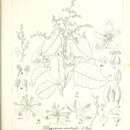Comments
provided by eFloras
Plants with leaves less-conspicuously veined, flowering August to October, and growing in seasonally moist habitats in central and western Texas are recognized by some authors as Polygonum texense or P. striatulum var. texense (M. Costea and F. J. Tardif 2003).
- license
- cc-by-nc-sa-3.0
- copyright
- Missouri Botanical Garden, 4344 Shaw Boulevard, St. Louis, MO, 63110 USA
Description
provided by eFloras
Plants perennial, light green, heterophyllous; rhizomes brown, 0.7-3 cm diam. Stems erect to ascending, sparingly branched in distal 1/ 2, not wiry, 25-60 cm. Leaves: ocrea 6-12 mm, proximal part cylindric, distal part soon disintegrating into brown fibers, later leaving almost no fibrous remains; petiole 0-2 mm; blade light green, linear-lanceolate to oblanceolate, 8-35 × 2-8 mm, margins flat, apex acute or obtuse; stem leaves 2.1-4 times as long as adjacent branch leaves; distal leaves sharply reduced, not overtopping flowers (shorter than or equaling flowers). Inflorescences axillary and terminal, spikelike; cymes in distal nodes, 2-6-flowered. Pedicels exserted from ocreae, 2-4 mm. Flowers semi-open; perianth 2-3.5 mm; tube 18-25% of perianth length; tepals overlapping, green with white or sometimes pink margins, petaloid, not keeled, oblong to obovate, cucullate; midveins usually unbranched; stamens 7-8. Achenes enclosed in perianth, brown, ovate, 3-gonous, (1.6-)1.8-2.6(-3) mm, faces subequal or unequal, apex not beaked, edges concave, shiny, smooth or roughened; late-season achenes common, 4-6 mm.
- license
- cc-by-nc-sa-3.0
- copyright
- Missouri Botanical Garden, 4344 Shaw Boulevard, St. Louis, MO, 63110 USA
Flowering/Fruiting
provided by eFloras
Flowering Dec-Mar or Jun-Oct.
- license
- cc-by-nc-sa-3.0
- copyright
- Missouri Botanical Garden, 4344 Shaw Boulevard, St. Louis, MO, 63110 USA
Habitat
provided by eFloras
Seasonal moist places, sterile prairies, granitic soils; 100-700m.
- license
- cc-by-nc-sa-3.0
- copyright
- Missouri Botanical Garden, 4344 Shaw Boulevard, St. Louis, MO, 63110 USA
Synonym
provided by eFloras
Polygonum striatulum var. texense (M. C. Johnston) Costea & Tardif; P. texense M. C. Johnston
- license
- cc-by-nc-sa-3.0
- copyright
- Missouri Botanical Garden, 4344 Shaw Boulevard, St. Louis, MO, 63110 USA
Polygonum striatulum: Brief Summary
provided by wikipedia EN
Polygonum striatulum, the striped knotweed or Texas knotweed, is endemic to the U.S. state of Texas but cultivated as an ornamental elsewhere. It occurs there in sterile prairies, granitic soils, and in places that are seasonally moist, at elevations of 100–700 m (330–2,300 ft).
Polygonum striatulum is a perennial herb that spreads by means of underground rhizomes. Leaves are lanceolate, up to 35 mm (1.4 in) long, the leaves in the upper part of the plant decidedly larger than those closer to the ground. Inflorescences are at the top of the plant and also at the tips of branches, each with 2–6 white to pinkish flowers.
- license
- cc-by-sa-3.0
- copyright
- Wikipedia authors and editors

